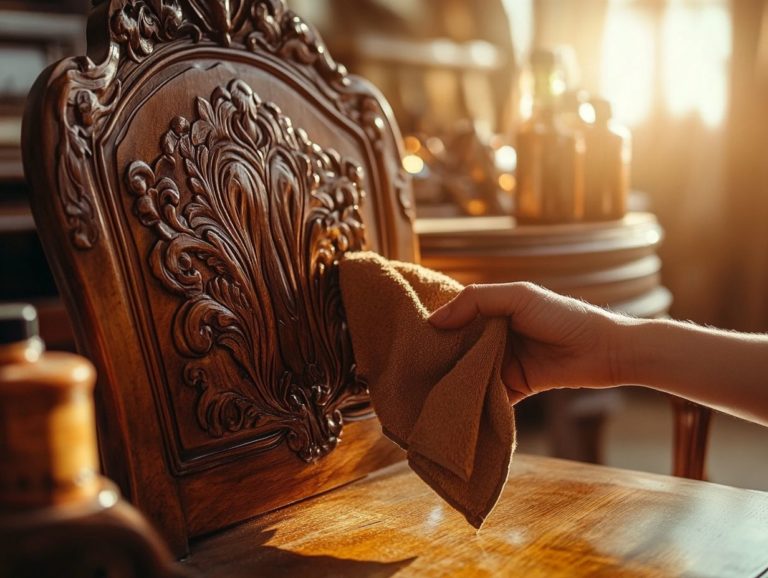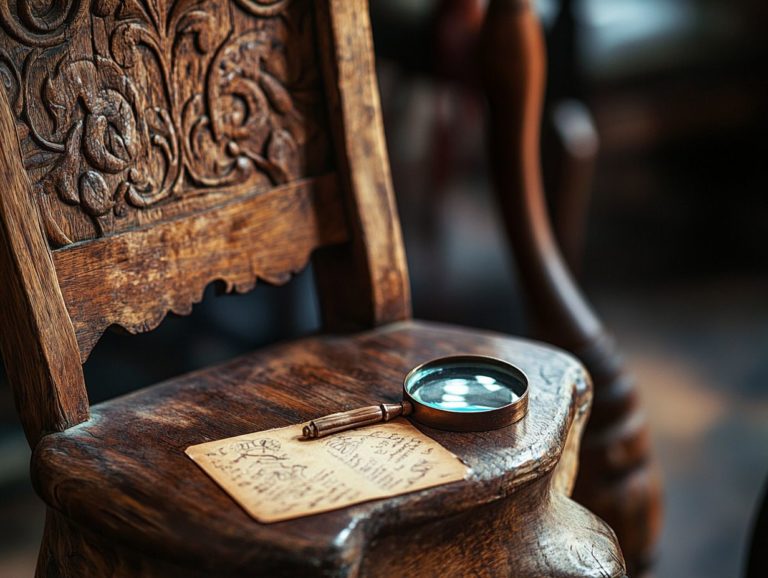The Best Vintage Furniture Restoration Supplies
Restoring vintage furniture can be an immensely rewarding and creative endeavor, allowing you to breathe new life into cherished pieces that tell a story.
Whether you’re a seasoned DIY enthusiast or just beginning your journey, having the right supplies is essential for achieving stunning results that truly reflect your vision.
From indispensable sanding tools to the perfect finishes, this guide will provide you with a curated list of must-have products that will elevate your restoration projects to new heights.
You’ll also discover valuable tips on selecting materials, ensuring safety, and avoiding common pitfalls, making your foray into furniture restoration both enjoyable and successful.
Get ready to turn your vintage finds into stunning treasures that will amaze everyone!
Contents
- Key Takeaways:
- 1. Sandpaper and Sanding Tools
- 2. Wood Stain and Finish
- 3. Paint and Primer
- 4. Brushes and Rollers
- 5. Protective Gear
- 6. Wood Filler and Putty
- 7. Screwdrivers and Other Hand Tools
- 8. Wood Glue
- 9. Wax and Polishing Cloths
- 10. Varnish and Polyurethane
- 11. Sanding Blocks and Sponges
- 12. Steel Wool
- 13. Mineral Spirits and Other Cleaning Supplies
- 14. Paint Strippers and Removers
- 15. Wood Conditioner
- What Are the Essential Tools for Restoring Vintage Furniture?
- Frequently Asked Questions
- What are the best supplies for restoring vintage furniture?
- Where can I find quality vintage furniture restoration supplies?
- Why are the right supplies crucial for restoring vintage furniture?
- Can I use modern furniture restoration supplies on vintage furniture?
- Are there any eco-friendly options for vintage furniture restoration supplies?
- What should I consider when choosing vintage furniture restoration supplies?
Key Takeaways:
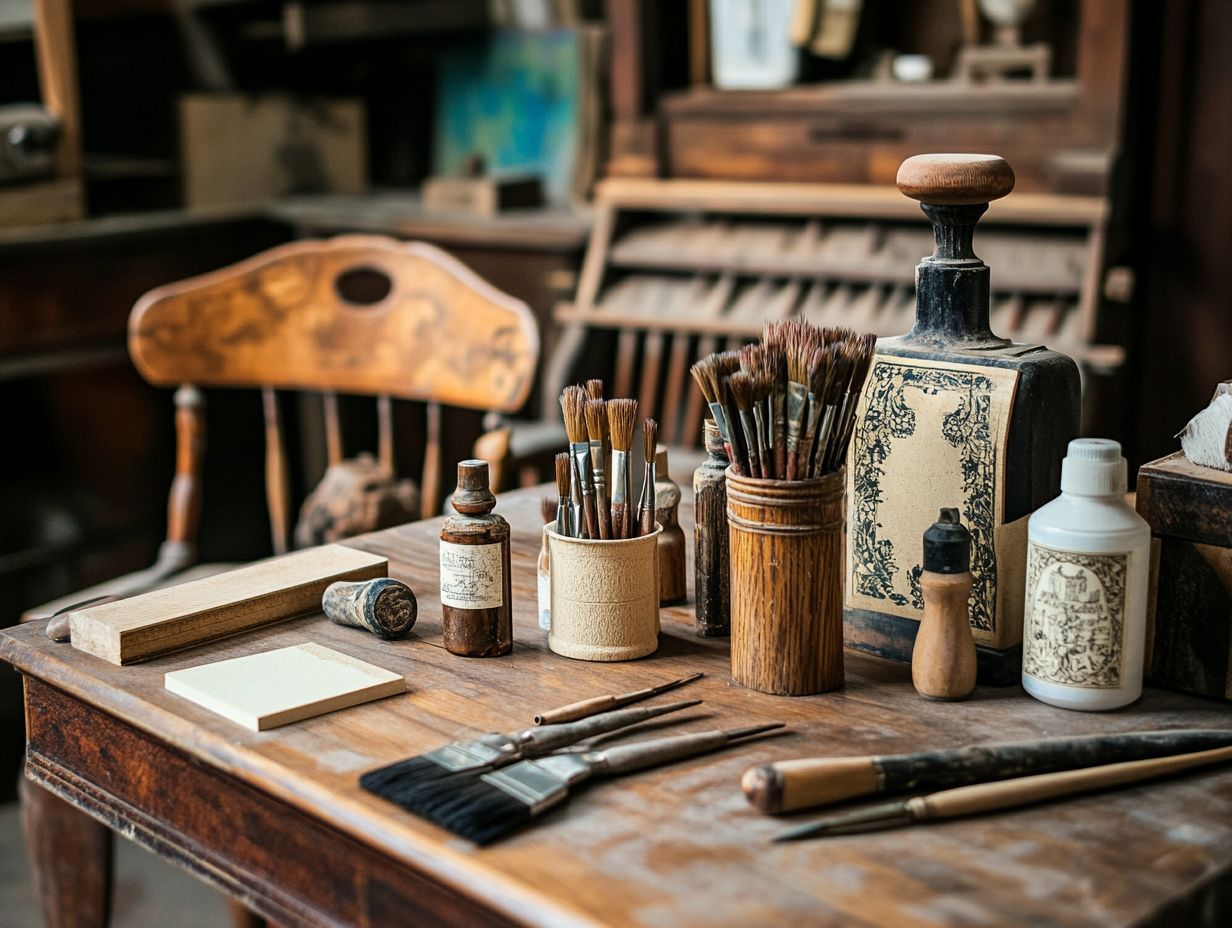
- Use sandpaper to smooth rough surfaces and remove old finishes.
- Enhance your furniture’s beauty with the right wood stain and finish.
- Apply restoration supplies properly for safe and effective results.
1. Sandpaper and Sanding Tools
When you embark on a furniture restoration project, recognizing the significance of the right sandpaper and sanding tools is essential for achieving a flawless finish and preserving the timeless charm of antique pieces.
This knowledge gives you the power to tackle your restoration endeavors with confidence.
Different types of sandpaper, like aluminum oxide and garnet (a type of sandpaper made from natural materials), cater to specific restoration needs. Grit levels vary from coarse (40-60) for stripping away old finishes to fine (220 and above) for polishing wood surfaces.
Employing tools like sanding blocks or orbital sanders (a power tool that moves in a circular motion, making sanding faster) can enhance your efficiency and control, reducing the risk of over-sanding.
The secret to successful restoration doesn t lie solely in the sanding process; it’s about how it intertwines with other techniques like staining or sealing. A well-prepared surface paves the way for better adhesion and an improved appearance of subsequent layers, ultimately accentuating the beauty and character of your furniture.
2. Wood Stain and Finish
Selecting the right wood stain and finish is crucial for enhancing the natural beauty of your antique furniture while ensuring quality craftsmanship and durability in your restoration projects.
With a variety of wood stains available oil-based, water-based, and gel options each offers unique advantages. Some penetrate deeply into the wood grain, while others provide a more uniform appearance on the surface.
It’s essential for you to consider how these different types will interact with the existing colors and textures of the antique piece. Striking the right balance can either breathe new life into the furniture’s charm or risk overshadowing it.
Application techniques vary, especially between oil-based stains and water-based counterparts, as oil-based stains usually demand longer drying times. A thoughtful approach to matching existing hues, paired with a bit of patience during application, plays a significant role in achieving that authentic and timeless finish you desire.
3. Paint and Primer
Using the right paint and primer is essential for your furniture restoration projects, especially when you re looking to breathe new life into vintage-inspired pieces or add a fresh twist to an antique gem.
Choosing the right types of paint and primer can dramatically affect the final look and longevity of your furniture. It s crucial to ensure the piece can withstand daily use while showcasing its unique charm.
Water-based primers are excellent for wooden surfaces, creating a smooth foundation that makes your chosen colors pop. Conversely, oil-based primers excel in adhesion and are perfect for metal surfaces.
As you select colors, consider the existing decorative hardware; the right shades can truly elevate their aesthetic. Employing proper application techniques, like layering and sanding between coats, will further enhance the finish, resulting in a stunning restoration that beautifully marries form and function.
4. Brushes and Rollers
Selecting the right brushes and rollers is crucial for achieving an impeccable finish in your furniture restoration endeavors. These tools allow you to apply paint, primers, and stains with true craftsmanship.
With many options at your disposal, it s vital to choose brushes tailored for intricate details versus those designed for expansive surfaces. For example, a fine-tipped brush is perfect for tight corners and detailed work, ensuring that every nook and cranny is meticulously covered. Conversely, high-density foam rollers, or special rollers designed for even coverage, excel at applying a smooth, even coat across larger areas while expertly minimizing texture.
Each tool plays a distinct role in helping you achieve that sought-after professional sheen. Regularly clean and properly store your brushes and rollers to extend their lifespan and ensure they deliver optimal performance on every restoration project. Invest in high-quality furniture refinishing supplies for amazing results!
5. Protective Gear
When diving into furniture restoration, it s essential to wear the right protective gear to ensure your safety while navigating the world of woodworking tools and restoration supplies especially when dealing with chemicals and power tools. Using cleaning supplies can further enhance your safety.
Proper gloves create a vital barrier against toxic substances and rough materials, keeping cuts and skin irritation at bay. Masks protect you from inhaling harmful fumes and dust particles that might arise during sanding or staining.
Don t overlook goggles; they shield your eyes from flying debris and pesky chemical splashes that can lead to serious risks. By equipping yourself with this essential protective gear, you can work confidently, honing your craft while minimizing exposure to potential hazards that come with restoration projects.
6. Wood Filler and Putty
Wood filler and putty are essential tools in your furniture repair arsenal, especially when tackling imperfections in antique pieces. They empower restoration enthusiasts like you to revive quality craftsmanship and elevate the overall finish of your projects.
Understanding the different types available can influence your restoration outcomes. Water-based fillers dry quickly and are convenient, while solvent-based options often deliver a more durable finish. Each type has its own application methods; some may require sanding, while others can be smoothly inserted directly into cracks and holes for that flawless look.
When choosing the right product, factor in the wood species, the extent of damage, and the finish you’re aiming for. Test a small area first before fully committing to any filler or putty. This ensures compatibility with existing finishes and helps you achieve the best possible results.
7. Screwdrivers and Other Hand Tools
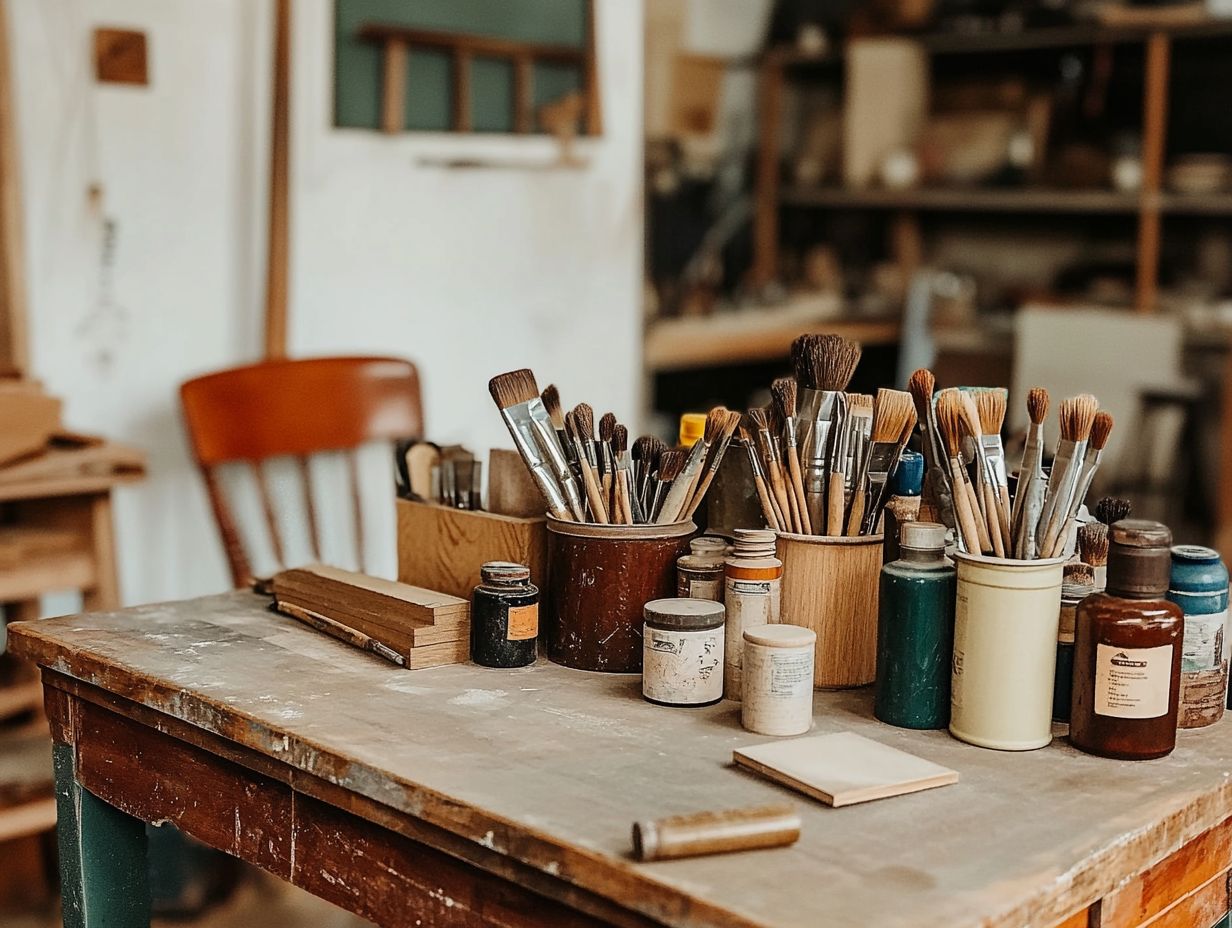
Utilizing the right screwdrivers and hand tools is essential for your journey in furniture restoration. These tools allow you to efficiently assemble, disassemble, and repair various components of antique pieces.
A well-stocked toolkit makes all the difference, as each tool serves a unique purpose. For example:
- Chisels are crucial for removing old glue and fine-tuning joints.
- A reliable hammer drives nails without damaging delicate wood.
- Adjustable wrenches are invaluable for loosening stubborn bolts.
- A putty knife ensures smooth application of fillers and finishes.
Together, these tools enhance your precision and efficiency, helping to preserve the integrity and beauty of each piece. This makes the entire restoration process thorough and ultimately rewarding.
8. Wood Glue
Wood glue is essential in furniture restoration. It provides the strong bonds needed to ensure your projects succeed while maintaining the integrity of antique pieces.
If you re diving into such projects, understanding the various types of wood glue is vital. For most indoor applications, PVA (polyvinyl acetate) glue is a common choice, while polyurethane glue offers waterproof properties, making it ideal for outdoor use or high-humidity environments. You ll also find specialty glues designed for specific materials, like epoxy for metal or ceramic joints.
To achieve the best bonding results, prepare the surfaces carefully. Clean and sand them to ensure a tight fit before applying the adhesive. This meticulous approach leads to lasting repairs, preserving the beauty and functionality of your cherished furniture. Using waxes and polishes can enhance the final touch.
9. Wax and Polishing Cloths
Wax and polishing cloths are important tools in your furniture care arsenal. They not only elevate the finish of restored pieces but also provide essential protection for your vintage decor, ensuring it remains stunning over time.
When used effectively, these products can dramatically extend the life of your cherished items, especially in furniture restoration. Regular wax application creates a protective barrier against dust and moisture two notorious foes of wood surfaces. The process is simple: just buff the wax into the surface with a soft cloth, covering every inch evenly.
You ll love how the gentle buffing action nourishes the wood and makes it stronger. By incorporating these straightforward steps into your regular maintenance routine, you can keep your antique furniture looking immaculate while preserving its historical charm.
10. Varnish and Polyurethane
Applying varnish and polyurethane is crucial for achieving a high-quality finish on your restored furniture. This not only protects against wear and tear but also enhances the aesthetic appeal of each piece.
Each option has distinct properties that influence application and long-term performance. Varnish gives a warm glow and lets the wood grain shine through, ideal for pieces where authenticity is paramount. In contrast, polyurethane offers superior durability and moisture resistance, making it a favored choice for high-traffic areas.
Recognizing these differences will guide your application technique whether you’re using a brush or a spray and affect how each finish retains its beauty. This knowledge ensures your restored furniture maintains its charm and integrity for years to come, making it a true character piece.
11. Sanding Blocks and Sponges
Sanding blocks and sponges are important tools in your furniture restoration journey. They provide the precision necessary for a successful project and a beautifully smooth finish.
These tools come in various shapes and materials, each crafted for specific tasks. For instance, a flat sanding block is perfect for leveling surfaces on larger flat areas. In contrast, contour sanding blocks excel at navigating curves and intricate details, especially in furniture renovation.
Sanding sponges, with their flexibility, conform effortlessly to surface contours, making them effective in corners and edges. When used together, these tools enhance traditional sanding methods, seamlessly supporting both electric sanders and hand-sanding techniques.
This thoughtful combination ensures that every nook and cranny receives the attention it deserves, leading to a flawless finish that highlights the craftsmanship you can take pride in.
Start your restoration journey today and bring your furniture back to life!
12. Steel Wool
Steel wool is a must-have for every restoration enthusiast! It s essential in furniture restoration, used for both cleaning and finishing surfaces. This versatile tool enhances the beauty of antique furniture, making it a staple in restoration supplies online.
Different types of steel wool, from coarse to fine, each play important roles in the restoration process. Coarse types are necessary for heavy-duty tasks like stripping away old finishes or paint, while finer types excel in polishing and preparing surfaces for new finishes key in furniture care products.
Choosing the right type is crucial, depending on the wood and the outcome you wish to achieve for your unique design. Wear gloves and a mask to protect yourself from dust and particles that come with various cleaning supplies.
When using steel wool, make sure to work with the grain of the wood. This keeps the wood looking great and ensures the best results in your restoration projects.
13. Mineral Spirits and Other Cleaning Supplies
Mineral spirits and other cleaning supplies are critical for preparing your furniture for restoration. They ensure your vintage decor pieces are spotless and ready for refinishing, essential for any restoration hardware project.
Alongside mineral spirits, denatured alcohol and other cleaning supplies are great at tackling stubborn grime without damaging the wood s finish. For a thorough cleanse, a gentle soap solution works wonders, especially on painted surfaces that need a delicate touch, enhancing your furniture care products collection.
For dusting, microfiber cloths are your best friends; they trap particles without scratching delicate finishes, an essential tool in your restoration supplies online toolkit. If you’re looking to enhance your skills, consider exploring the best vintage furniture restoration workshops. Each of these supplies plays a vital role in the restoration journey, helping you revive the beauty of your cherished pieces while preserving their historical charm.
14. Paint Strippers and Removers
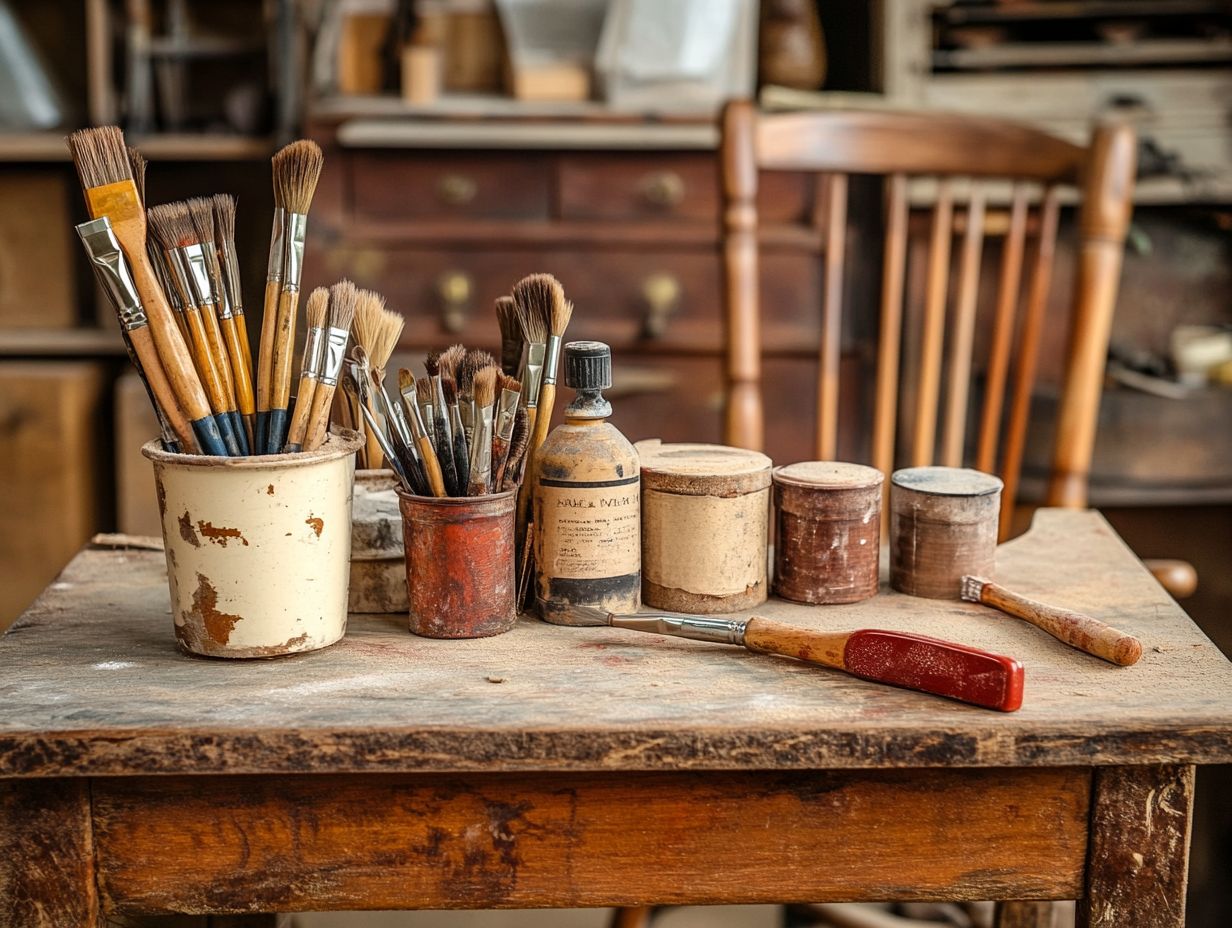
Paint strippers and removers are essential tools in your furniture renovation arsenal. They help you strip away old finishes and prepare surfaces for a fresh look maintaining a standard of quality craftsmanship that reflects your dedication.
These products come in various types, from chemical to eco-friendly options, designed for different kinds of paint and surfaces. Depending on your project, you might choose a strong remover for stubborn layers or a bio-based alternative for a more environmentally friendly option.
Application methods vary; use brush-on techniques for detailed work or spray formulas to cover larger areas quickly. Remember to follow safety precautions wear gloves and masks, ensure ventilation, and protect surrounding areas from splatter, especially with restoration supplies that contain chemicals.
By following these guidelines, you enhance your safety and boost the overall success of your restoration endeavors, ensuring you achieve your desired furniture functionality!
15. Wood Conditioner
Using a wood conditioner is a crucial step in your furniture restoration journey. It ensures a uniform stain and finish that elevates the craftsmanship of your project and highlights the unique design of your piece.
This process minimizes blotchiness and helps the wood absorb stain evenly. This is especially important when working with antique pieces, which are old furniture that has historical value and often have uneven porosity, requiring special attention in restoration.
You can apply the conditioner using various methods. A brush or cloth works beautifully, allowing you to reach every nook and cranny with precision, which is crucial for maintaining furniture accessories.
This step is vital because the absorption characteristics of older woods can differ significantly from modern varieties. Without proper conditioning, the final result may not meet your expectations, potentially overshadowing the beauty and history that these treasured items hold. This is why expert guidance is often recommended.
What Are the Essential Tools for Restoring Vintage Furniture?
Restoring vintage furniture demands a carefully curated collection of essential tools, including special tools for woodworking, hand tools, and restoration supplies. These tools ensure that you execute each project with precision and care, showcasing your quality restoration skills.
Equipping yourself with the right tools streamlines your restoration process and plays a pivotal role in preserving the unique character of each piece. Essential instruments, such as chisels, are critical for detailed carving and shaping, while sanders help achieve a smooth finish that highlights the wood’s inherent beauty.
Adhesives specifically formulated for furniture will securely bond joints and repairs. This ensures the structural integrity of your work and enhances the overall furniture functionality.
A high-quality paintbrush or spray gun is also vital for applying finishes uniformly. This gives your project that polished, professional touch that is a hallmark of quality craftsmanship.
By harnessing these essential tools, you will dramatically boost the longevity and aesthetic appeal of vintage treasures, turning them into beautiful, functional pieces that tell a story for years to come. For those looking to enhance their outdoor areas, exploring the best vintage furniture for outdoor spaces can embody the very essence of restoration craftsmanship.
How Can These Supplies Help with Different Restoration Techniques?
Utilizing the right restoration supplies is essential when applying various restoration techniques. Each method enhances the quality craftsmanship of the finished piece while preserving the integrity of antique furniture.
Techniques like sanding, staining, and repairing joints will dramatically boost the look and lifespan of the furniture. They are crucial for any furniture restoration projects.
For example, using high-quality sandpaper and power tools can remove old finishes with remarkable precision, ensuring the best results in your restoration projects. Specialty wood fillers and adhesives will help you repair small cracks and damaged areas seamlessly, maintaining the piece’s character. If you’re looking to enhance your projects with unique pieces, consider exploring where to buy vintage furniture online.
Varnishes and waxes reveal the wood’s natural beauty while also protecting it from future wear. They are essential components of furniture care products.
Choosing the right brushes and application tools will ensure that your restoration process is smooth and effective. This ultimately transforms a piece into a stunning work of art that retains its historical charm and embodies craftsmanship excellence.
Grab your tools and start restoring your vintage treasures today!
What Are the Key Factors to Consider When Choosing Restoration Supplies?
When selecting restoration supplies, consider key factors like premium quality and compatibility with antique furniture.
Your specific needs as a restoration enthusiast will also ensure success in your vintage-inspired projects.
Evaluating the durability and effectiveness of the products is paramount. High-quality supplies often dictate the longevity of your restoration efforts.
It s essential to choose materials that are compatible with the specific types of wood, metals, or fabrics involved in your project.
Prioritize user experience. Opting for supplies that come with clear instructions and reliable customer support can significantly enhance your restoration journey.
Reading reviews and seeking professional recommendations can further aid in making informed decisions. This ultimately leads to a more satisfying outcome for you as a restoration enthusiast.
How Can One Ensure the Safety and Effectiveness of These Supplies?
Your restoration supplies need to be safe and effective to make your project a success, especially when dealing with cleaning products that require protective gear to safeguard your health.
Proper ventilation plays a critical role in any restoration project. It helps disperse harmful vapors that may accumulate while using chemical agents.
Always strive to work in well-ventilated spaces or employ exhaust fans to minimize inhalation risks. This ensures you can work effectively on your vintage-inspired projects without compromising safety.
Adhere to handling precautions, like wearing gloves and eye protection, to avoid direct contact with hazardous substances.
By following the manufacturer s guidelines, you enhance the efficacy of your restoration efforts while significantly reducing potential safety hazards that could arise from improper usage or the mixing of materials.
What Are Some Common Mistakes to Avoid When Using These Supplies?
Avoiding common mistakes with restoration supplies is essential for ensuring your project s success and achieving the high-quality craftsmanship you desire in furniture restoration.
This involves understanding the specific requirements of various materials and finishes, as these can greatly influence the final outcome.
Many restoration enthusiasts rush through the preparation phase, overlooking the importance of thoroughly cleaning or sanding surfaces. This oversight can lead to poor adhesion of paints or stains.
Misjudging the correct application techniques, such as using the wrong type of brush or applying too thick a coat, can result in uneven finishes or unsightly drips.
By taking the time to educate yourself and follow best practices, you can elevate your work and achieve results that truly reflect your passion for craftsmanship. This ensures your craftsmanship is evident in every character piece.
Frequently Asked Questions
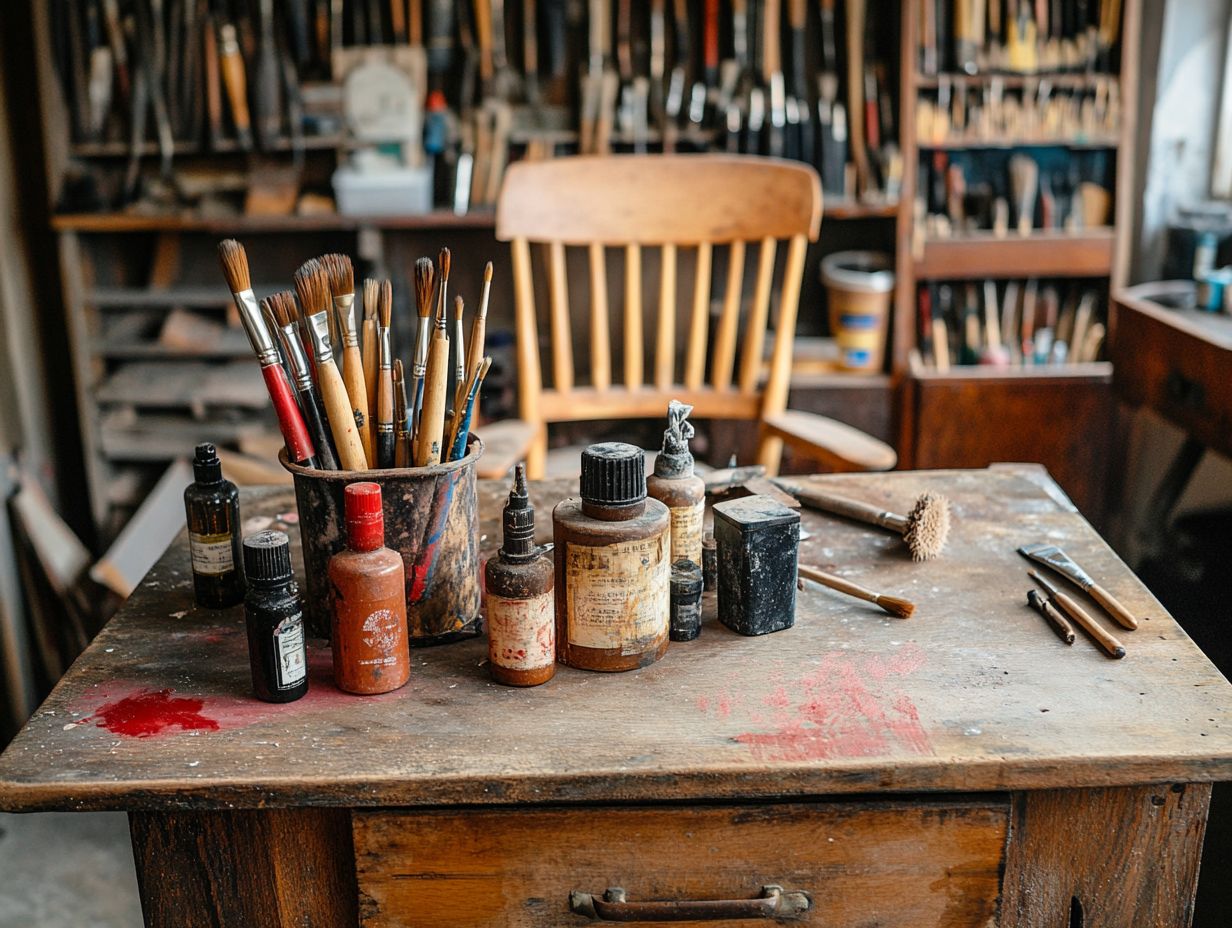
What are the best supplies for restoring vintage furniture?
The best supplies for restoring vintage furniture vary depending on the type of furniture and the level of restoration needed.
Some essential supplies include furniture refinishing supplies such as sandpaper, wood glue, wood stain or paint, and a good quality varnish or wax for finishing.
Where can I find quality vintage furniture restoration supplies?
You can find quality vintage furniture restoration supplies at your local hardware store or online from specialty restoration supply companies.
Check out flea markets and antique stores for unique and authentic supplies.
Why are the right supplies crucial for restoring vintage furniture?
The right supplies can transform your project, giving it a professional finish and ensuring durability.
Can I use modern furniture restoration supplies on vintage furniture?
Some modern furniture restoration supplies may work on vintage pieces. However, it is best to use supplies specifically designed for restoring vintage furniture.
Are there any eco-friendly options for vintage furniture restoration supplies?
You can find plenty of eco-friendly options for vintage furniture restoration. Look for non-toxic products made from natural ingredients to protect both your furniture and the planet!
What should I consider when choosing vintage furniture restoration supplies?
Consider the type of furniture and the level of restoration needed. Research different products and read reviews to ensure you use the best supplies for your project.


